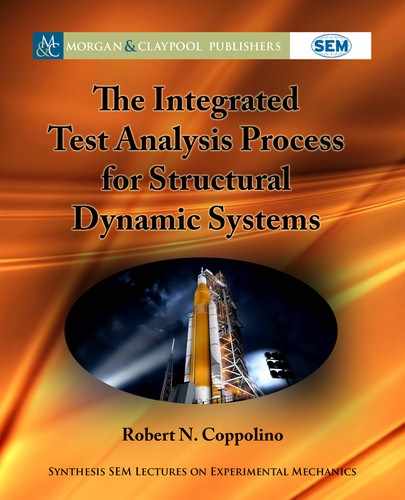3.2. PART 2: TARGET MODE SELECTION 49
Resulting in the transformed system equations,
M
ii
M
0
ib
M
0
bi
M
0
bb
R
U
0
i
R
U
b
C
B
ii
B
0
ib
B
0
bi
B
0
bb
P
U
0
i
P
U
b
C
K
ii
0
ib
0
bi
K
0
bb
U
0
i
U
b
D
ie
0
ib
‰
T
ib
ie
I
bb
F
ie
F
b
C
iN
0
bN
f
F
N
g
:
(3.28)
Application of the modal transformation (real, undamped modes) of the upper partition
of Equation (3.27),
U
0
i
U
b
D
ˆ
in
0
ib
0
bi
I
bb
q
n
U
b
;
Œ
ˆ
in
T
Œ
M
ii
Œ
ˆ
in
D
Œ
I
nn
;
Œ
ˆ
in
T
Œ
K
ii
Œ
ˆ
in
D
!
2
n
;
(3.29)
results in the “modal” dynamic equations,
I
nn
P
nb
P
bn
M
0
bb
Rq
n
R
U
b
C
2
n
!
n
0
nb
0
bn
B
0
bb
Pq
n
P
U
b
C
!
2
n
0
nb
0
bn
K
0
bb
q
n
U
b
D
ˆ
T
in
ie
0
nb
‰
T
ib
ie
I
bb
F
ie
F
b
C
ˆ
T
in
iN
0
bN
f
F
N
g
:
(3.30)
Note, the damping coupling partitions are commonly assumed to have the following prop-
erties:
ˆ
T
in
B
ii
ˆ
in
D
Œ
2
n
!
n
;
ˆ
T
in
B
0
ib
D
Œ
0
nb
;
B
0
bi
ˆ
in
D
Œ
0
bn
: (3.31)
3.2.3 MODAL EFFECTIVE MASS AND TARGET MODE SELECTION
e mass coupling partitions, called modal partition factors are defined as,
Œ
P
nb
D
ˆ
T
in
M
0
ib
;
Œ
P
bn
D
Œ
P
nb
T
: (3.32)
e modal effective mass associated with one individual mode “n” is defined as,
Œ
Meff
bb
n
D
Œ
P
bn
Œ
P
nb
: (3.33)
e product of the above two modal participation matrices is called the modal effective
mass for mode “n”. e sum of all modal effective masses approaches the boundary mass parti-
tion, i.e.,
X
n
Œ
Meff
bb
n
!
M
0
bb
: (3.34)
A linear structure excited only by boundary acceleration has modal accelerations that are
stimulated by allocations proportional to the modal participation factors. A convenient form that
is commonly employed to evaluate the significance of individual modal responses (i.e., target
mode selection) is normalized modal effective mass, specifically defined:
..................Content has been hidden....................
You can't read the all page of ebook, please click here login for view all page.
